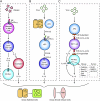Alternatively activated macrophages and airway disease
- PMID: 21896520
- PMCID: PMC3168852
- DOI: 10.1378/chest.10-2132
Alternatively activated macrophages and airway disease
Abstract
Macrophages are the most abundant immune cell population in normal lung tissue and serve critical roles in innate and adaptive immune responses as well as the development of inflammatory airway disease. Studies in a mouse model of chronic obstructive lung disease and translational studies of humans with asthma and COPD have shown that a special subset of macrophages is required for disease progression. This subset is activated by an alternative pathway that depends on production of IL-4 and IL-13, in contrast to the classic pathway driven by interferon-γ. Recent and unexpected results indicate that alternatively activated macrophages (AAMs) can also become a major source of IL-13 production and, thereby, drive the increased mucus production and airway hyperreactivity that is characteristic of airway disease. Although the normal and abnormal functions of AAMs are still being defined, it is already apparent that markers of this immune cell subset can be useful to guide stratification and treatment of patients with chronic airway diseases. Here, we review basic and clinical research studies that highlight the importance of AAMs in the pathogenesis of asthma, COPD, and other chronic airway diseases.
Figures

References
Publication types
MeSH terms
Substances
LinkOut - more resources
Full Text Sources
Other Literature Sources
Medical

